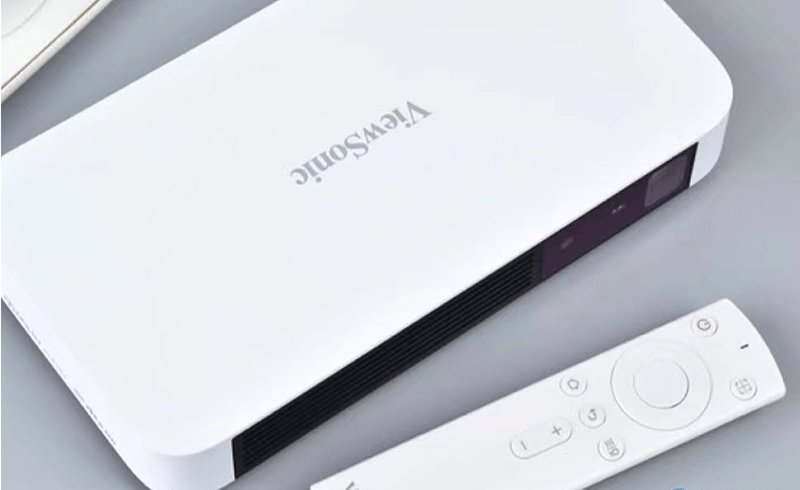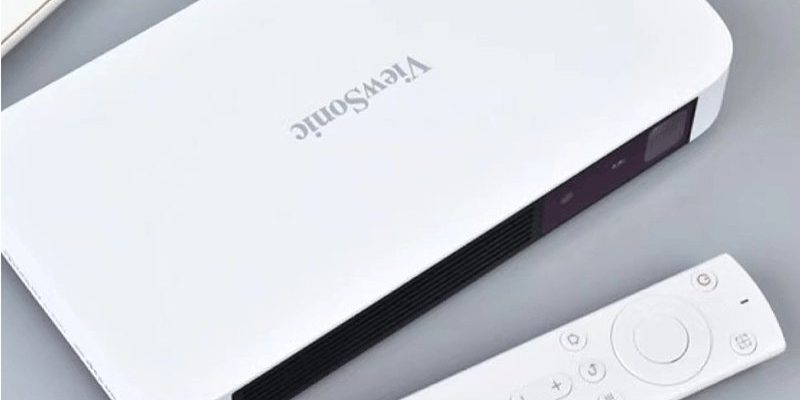
People expect remotes to be like magic wands these days. Why shouldn’t one click command them all? But when it comes to Viewsonic projector remotes, things aren’t always so straightforward, especially if you’re new to projectors or AV setups in general. Let me explain how these remotes work, what they *can* control, and whether you can ditch the clutter and run your streaming devices (Roku, Fire Stick, Apple TV, etc.) right from your projector’s remote. By the end, you’ll have a much clearer picture of your options—and maybe a little less remote-induced frustration.
How Viewsonic Projector Remotes Actually Work
Here’s the thing: every remote has a language of its own. Most Viewsonic projector remotes are what you’d call “proprietary”—meaning, they’re built specifically for the projector’s functions. So, when you click ‘Source’ or ‘Menu,’ the remote speaks directly to your projector through infrared (IR) signals, just like a flashlight signaling Morse code. The projector “gets it” because it’s tuned to those exact codes.
But streaming devices like Roku or Fire TV also have their own IR codes, or sometimes use radio frequency (RF) or Bluetooth, making their language quite different. Your Viewsonic remote, out of the box, usually doesn’t know how to say, “Hey, Roku, play the next episode!” It’s like expecting someone with a walkie-talkie to chat with someone using a cell phone—possible, but not without some clever workarounds.
That said, not all hope is lost. Some Viewsonic models come with *universal remote features* or “learning” modes. But from what I’ve seen, most standard Viewsonic remotes don’t natively control third-party streaming devices. They’re designed for projector settings—volume, keystone, input, maybe a laser pointer if you’re feeling fancy.
Universal Remotes vs. Brand Remotes: What’s the Difference?
Let’s break this down. A universal remote is like that super-friendly neighbor who learns *everyone’s* names at the block party, while a brand remote (like the ones Viewsonic makes) tends to stick with its own family. Universal remotes can be programmed with the codes for dozens—sometimes hundreds—of devices, including both projectors and streaming devices. They’re the Swiss Army knife of remotes.
Viewsonic’s own remote, however, is usually more like a one-trick pony. You want to tweak the color mode, adjust the focus, or change the input? Perfect. But as for telling your Chromecast to queue up the next song? Not so much, unless you get lucky with a learning remote or unique integration.
There are some exceptions, of course. Some projectors (and higher-end Viewsonic models) support HDMI-CEC, a feature that lets one device “talk” to another over the HDMI cable. This means, in certain cases, a projector’s remote might control basic streaming stick functions. But—and it’s a big but—CEC compatibility is famously finicky, and not all remotes support it. It’s sort of like when you try to get two rival cats to share a sunny window spot. Sometimes it works, sometimes there’s hissing.
HDMI-CEC: The Hidden Pathway for Remote Control
Here’s where things get interesting: HDMI-CEC (Consumer Electronics Control). This little-known feature lets connected devices pass commands along the HDMI cable. So, if your Viewsonic projector supports HDMI-CEC and your streaming stick does too, there’s a chance you can control basic playback—think pause, play, or power—using the projector remote.
I’ve seen setups where plugging a Roku or Fire Stick into the HDMI-CEC-enabled projector lets you use the projector’s remote buttons for simple stuff. But don’t get your hopes up just yet. Results depend on *both* devices supporting CEC and having it enabled in the settings. Sometimes just turning it on feels like you’re conjuring magic, other times—nothing happens. It’s one of those “your mileage may vary” situations.
To check if your setup can do this:
- Look for HDMI-CEC settings in your Viewsonic projector’s menu (it can sometimes go by another name, like “Control” or “CEC”).
- Make sure your streaming stick’s settings have HDMI-CEC enabled. On a Roku, it’s under advanced system settings.
- Try using the remote’s arrow keys or play/pause to see if your streaming device responds.
If it works—amazing! If not, you’re not alone. Many folks end up using a separate remote anyway, just in case.
Pairing, Resetting, and Troubleshooting Viewsonic Remotes
You might be wondering, “Can I pair my Viewsonic remote with a streaming device directly?” Honestly, in almost all cases, you can’t—at least not the way you’d pair a Bluetooth remote or sync up a universal one. Viewsonic remotes are not coded to “learn” new devices. If you’re persistent, you could try a universal remote instead, but the stock remote is mostly locked in to just the projector.
If your projector remote *isn’t* working at all, it might be something simple: a weak battery (it happens far more often than you’d think), or dusty IR sensors on the projector. I’ve seen friends go into full troubleshooting mode—resetting the remote, checking for stuck buttons, even re-pairing if the model allows for it. Sometimes, just opening up the battery compartment and swapping in a fresh AA or AAA does the trick.
If you’re hoping for a remote hack, some “learning” remotes have a mode where you let them *watch* the commands from another remote and memorize them. But again, the standard Viewsonic remote isn’t built for this. If yours looks fancy or has a “learning” button, double-check your manual or Viewsonic’s support site.
Are There Workarounds? (Spoiler: Yes, but…)
Say you’re set on using just one remote for everything. You’ve got options, but it might take a little fiddling and patience.
- Get a universal remote: These are built to handle it all—projectors, streaming devices, audio systems. After programming, one click could rule them all. Just make sure yours supports both your projector’s code and your streaming stick’s.
- Use mobile apps: Many streaming devices and some newer projectors offer control via smartphone apps. If you’re like me and never put your phone down anyway, this can actually be easier than hunting for lost remotes.
- Opt for HDMI-CEC: If it works, great! Just keep in mind it usually covers only basic commands, not the full streaming device experience.
Sometimes, running everything through a fancy smart home setup (like Alexa or Google Home) can also tie multiple devices together, but that requires a few more steps and compatible hardware.
Comparing Remote Code Systems: Why It Matters
Let me break down what “remote codes” even mean, because this trips up a lot of people (myself included, that first time). Every electronic device—projector, TV, streaming stick—uses a set of digital codes to process remote commands. Think of it like a secret handshake; if the code isn’t just right, the device ignores you.
| Device | Typical Code Type | Can Viewsonic Remote Control? |
|---|---|---|
| Viewsonic Projector | Viewsonic-specific IR | Yes |
| Roku Streaming Stick | Roku IR / WiFi Direct | No (except via HDMI-CEC, limited) |
| Fire TV Stick | Bluetooth / CEC | No (except via HDMI-CEC, very limited) |
| Apple TV | Bluetooth / IR | No (except via HDMI-CEC, very limited) |
Universal remotes get around this by being “code collectors.” They store the secret handshakes for dozens of brands, so you can tell your projector, TV, and streaming stick what to do with just one gadget.
When to Consider a Universal Remote Instead
If I’m being honest, most home theater enthusiasts end up grabbing a universal remote eventually. It’s just so much easier. Imagine pressing one button to dim the lights, turn on your Viewsonic projector, set the correct input, and cue up your streaming device. Feels a bit like living in the future, right?
Universal remotes cost anywhere from $15 to fancy $200 models, but even the basic ones can make life simpler. They’re especially handy if you keep running into compatibility walls with HDMI-CEC or you’re tired of three remotes living on your coffee table. And if you want to impress guests by switching from Netflix to a PowerPoint presentation without juggling devices—it’s the way to go.
Still, if you only ever use your projector for one thing, and you’re fine using two remotes, there’s no need to complicate things. Sometimes, simpler is better.
What To Do If Your Viewsonic Remote Stops Working
Nothing makes movie night come to a screeching halt like a dead remote. If yours isn’t responding, don’t panic. Here are a few practical steps I usually try (sometimes with embarrassingly simple results):
- Change the batteries: Seriously, about half the time, that’s it.
- Clean the IR sensor: A dusty lens can block the signal. Wipe gently with a dry cloth.
- Double-check you have “line of sight”: IR requires a clear path, so there’s no point waving it behind your back (trust me, I’ve tried).
- Restart or reset: Power-cycle the projector and check for a reset button or sequence in your Viewsonic manual.
- Try another remote: Universal remotes or a replacement from Viewsonic can fill in if yours is really gone.
If you’re tech-savvy, sometimes updating the projector’s firmware (if available) can help with remote communication issues, but that’s pretty rare for most basic remote problems.
Final Thoughts: Can the Viewsonic Remote Be Your All-in-One?
So, what’s the bottom line? For most people, the answer to “Can Viewsonic projector remotes control streaming devices?” is: not directly. These remotes are loyal to their projectors, using unique IR codes that streaming devices don’t understand. There *are* workarounds—like HDMI-CEC compatibility or using a universal remote—but don’t expect a plug-and-play solution out of the box.
If you’re dreaming of a one-remote lifestyle, your best bet is to explore a universal remote, check your devices for HDMI-CEC support, or take advantage of mobile apps as backup. And if you ever find a way to magically get your Viewsonic remote to control everything, please let me know. I’ll be the first in line for that advice.
In the end, a little setup now can save you countless “Where did I put the remote?!” moments later. Here’s to seamless streaming, stress-free movie nights, and maybe—just maybe—a little less clutter on your coffee table.
